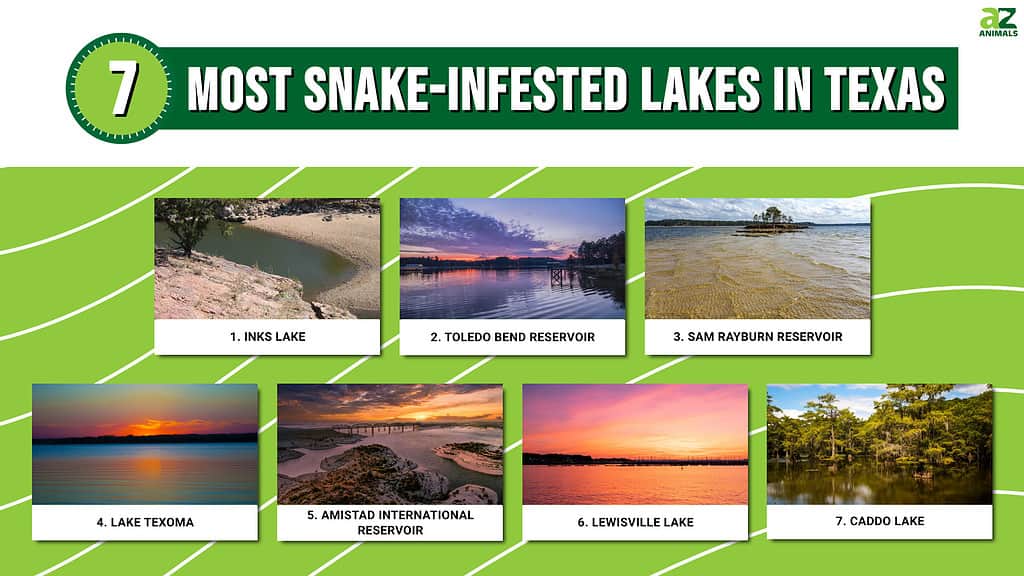
Texas undoubtedly claims the title for the greatest number of snake species in any American state. According to Texas Parks and Wildlife, the Lone Star State has more than 105 different species and subspecies of snakes, although only 15 of these are venomous or dangerous.
Given these numbers, it should come as no shock that snakes are commonly spotted in lakes statewide. However, lakes in some regions, such as the western, central, and southern parts of the state, have many more snakes than others.

This doesn’t mean snakes aren’t spotted in large numbers in lakes in other areas. Dallas, for example, is a northern city but has at least 30 snake species commonly spotted in and around its lakes. Below are 7 Texas lakes with large numbers of snakes.
1. Inks Lake
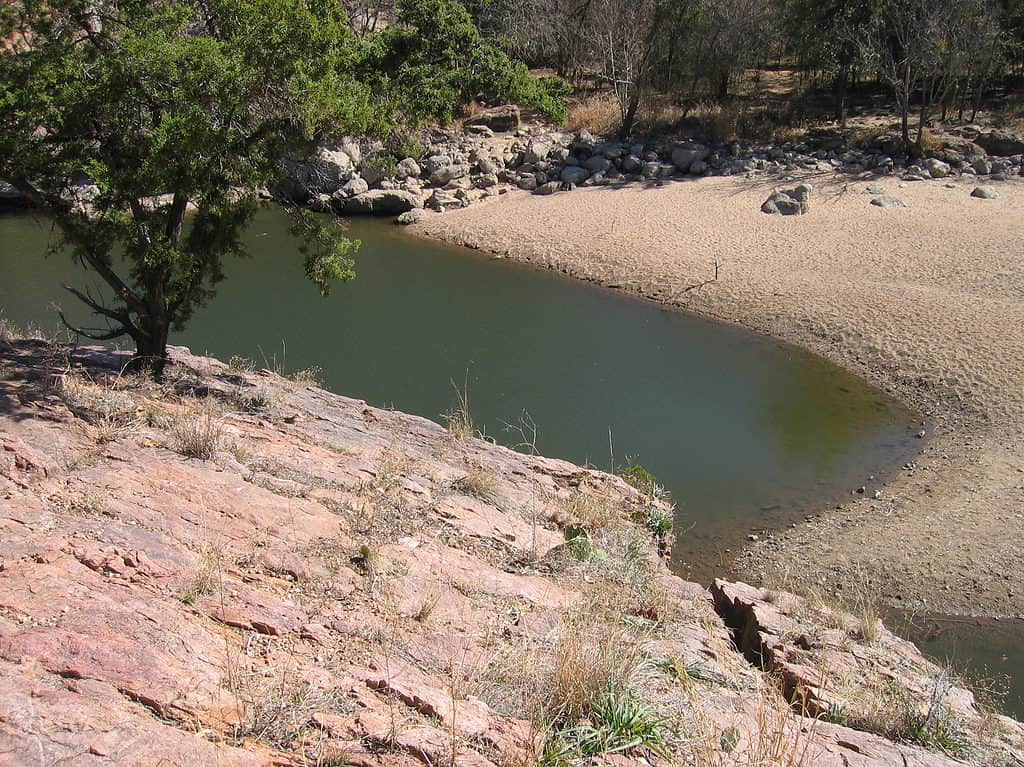
Ink’s Lake is low on water during a drought.
©iStock.com/borsheim
Inks Lake is a popular lake located in the Edwards Plateau on the Colorado River between the western, central, and southern parts of Texas. Considering the plateau’s placement, it’s no surprise that it’s a snake hotspot and that many of these snakes are found in and around Inks Lake.
According to Texas Wildlife and Parks, the most commonly spotted species is the nonvenomous diamondback water snake. The lake is also home to several venomous snakes, such as western cottonmouths, Texas coral snakes, and western diamondback rattlesnakes.
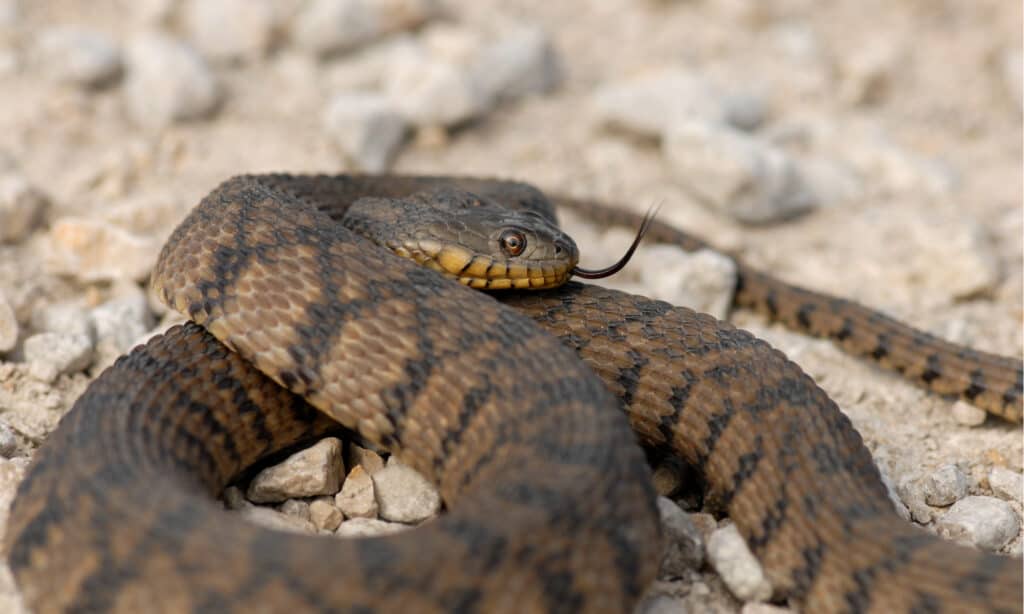
The non-venomous Diamondback water snake calls Inks Lake home.
©Rusty Dodson/Shutterstock.com
2. Toledo Bend Reservoir

Cottonmouths, canebrake rattlesnakes, and Texas coral snakes are some species spotted in Toledo Bend Reservoir.
©Bonnie Taylor Barry/Shutterstock.com
The Toledo Bend Reservoir is a Newton County lake in southeast Texas, a location known for its large snake population. The reservoir, which generates more than 92 megawatts of electrical power, has been operating since 1969. It is home to various venomous and non-venomous snake species.
The lake’s most venomous species are eastern cottonmouths, canebrake rattlesnakes, Texas coral snakes, Western pygmy rattlesnakes, and Southern copperheads. Several nonvenomous species, such as the Texas rat snake and the prairie king snake, have also been spotted here.
3. Sam Rayburn Reservoir
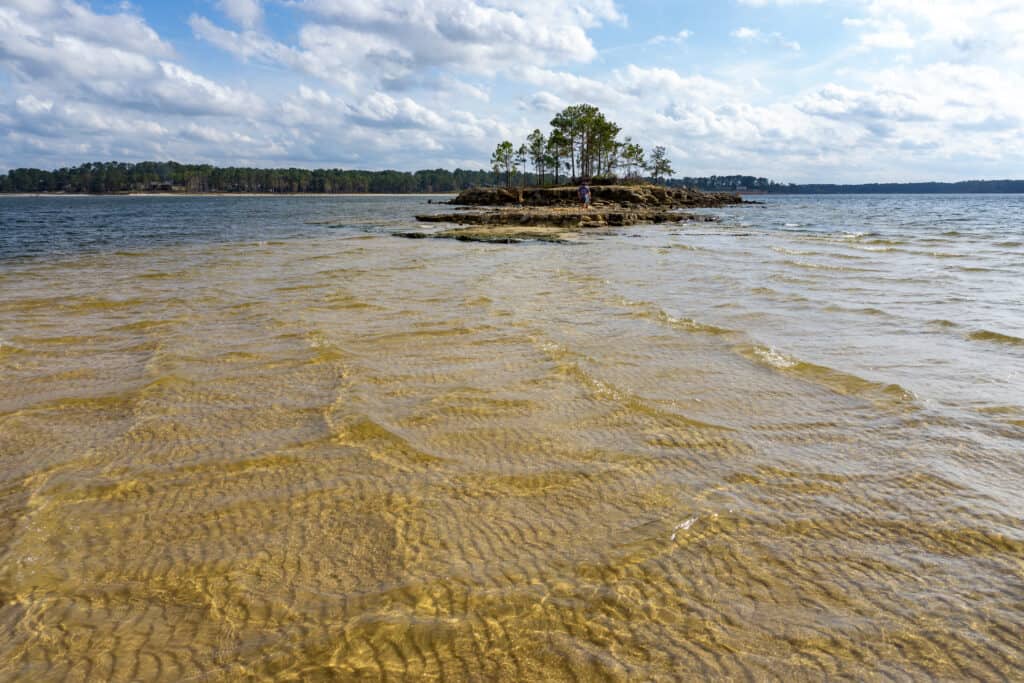
Sam Rayburn Reservoir is home to several snake species, including copperheads, Texas coral snakes, and rattlesnakes.
©Jordan Pitre/Shutterstock.com
This reservoir is located in Jasper County in the eastern part of the state. Although Texas’ east side isn’t as notorious for snake infestations, the state has large snake populations, so no location is entirely snake-free.
The lake stretches 36.43 miles and runs as deep as 80 feet in some areas. Despite this depth, snakes can be found in its shallower areas. The two most common species in and around the lake are venomous cottonmouths and copperheads. However, Texas coral snakes, rattlesnakes, and other aquatic species can also be spotted.
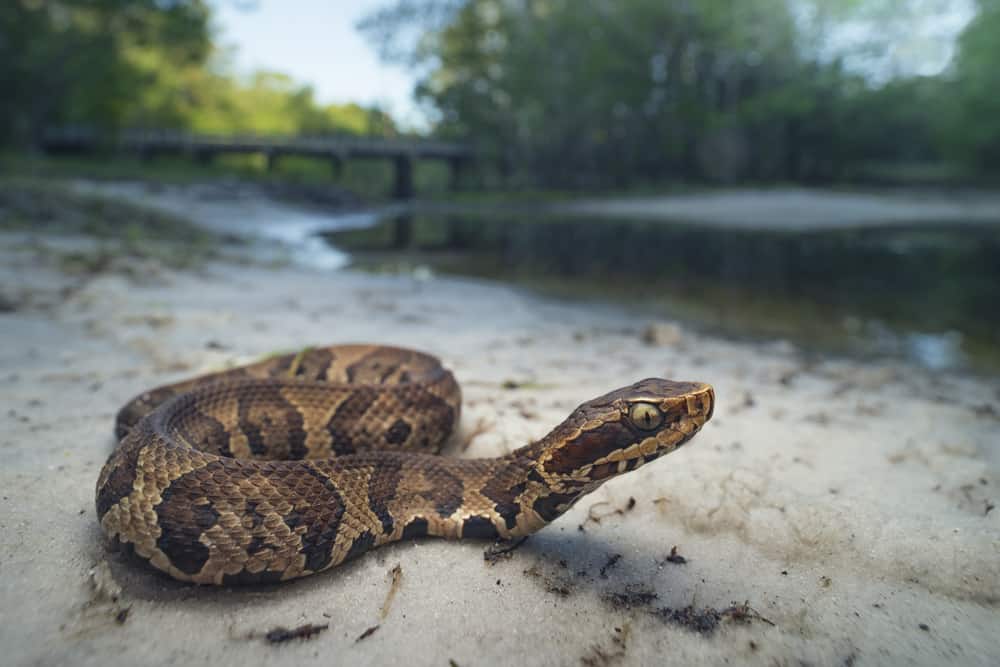
The Cottonmouth is one of the most populous snakes at the Sam Rayburn reservoir.
©Kristian Bell/Shutterstock.com
4. Lake Texoma

Lake Texoma is home to several venomous snakes, including copperheads, coral snakes, and cottonmouths.
©iStock.com/asiantiger247
Not fully contained in Texas, Lake Texoma, on the Oklahoma-Texas border, is considered one of the largest reservoirs in the country. This lake is known for its wide variety of freshwater fish. Some of the most common species in the lake are flathead catfish and various bass and crappie species.
If you’re visiting this lake, you should be very cautious as the area has several venomous snakes, including copperheads, coral snakes, and cottonmouths. The lake also houses several species of venomous rattlesnakes. These snakes aren’t only found in and around the lake but are also spotted in residential areas.
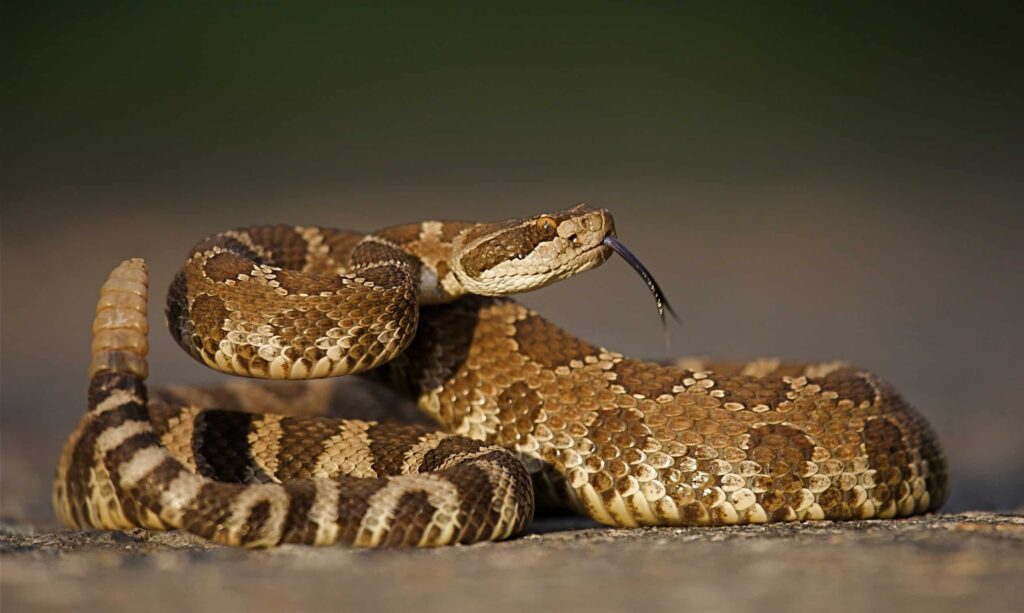
Lake Texoma has several species of rattlesnakes that can be found in and around the lake as well as in residential areas.
©Tom Reichner/Shutterstock.com
5. Amistad International Reservoir

Amistad Reservoir with the Governor’s Landing Bridge is beautiful at sunset.
©iStock.com/Wirestock
The Amistad International Reservoir is located in Val Verde, a lovely county in the southwestern parts of Texas. According to the National Park Service, there have been 37 confirmed reptile species in the area and 18 unconfirmed. These reptiles include turtles, lizards, and venomous and nonvenomous snakes.
Some of the most commonly-seen snake species in and around the lake are western ribbon snakes, Texas blind snakes, Texas indigo snakes, western diamondbacks, Trans-Pecos black-headed snakes, and rock rattlesnakes.
6. Lewisville Lake

Some of the snake species found around Lewisville Lake are yellow-bellied racers, speckled kingsnakes, and western coachwhips.
©ZeKing/Shutterstock.com
Lewisville Lake is an 11-mile lake located in north central Texas. It is known for its gorgeous scenery and wide variety of wildlife, including fish, mammals, and reptiles. According to Lewisville Lake Environmental Learning Area, the lake houses more than 36 reptile species, including alligators, turtles, and venomous and nonvenomous snakes.
The two venomous species found around the lake are the western cottonmouth and the copperhead. These snakes, often mistaken for each other, are known to bite more Americans than any other snake. Other spotted species include eastern yellow-bellied racers, speckled kingsnakes, western coachwhips, blotched water snakes, broad-banded water snakes, and diamondback water snakes.
7. Caddo Lake
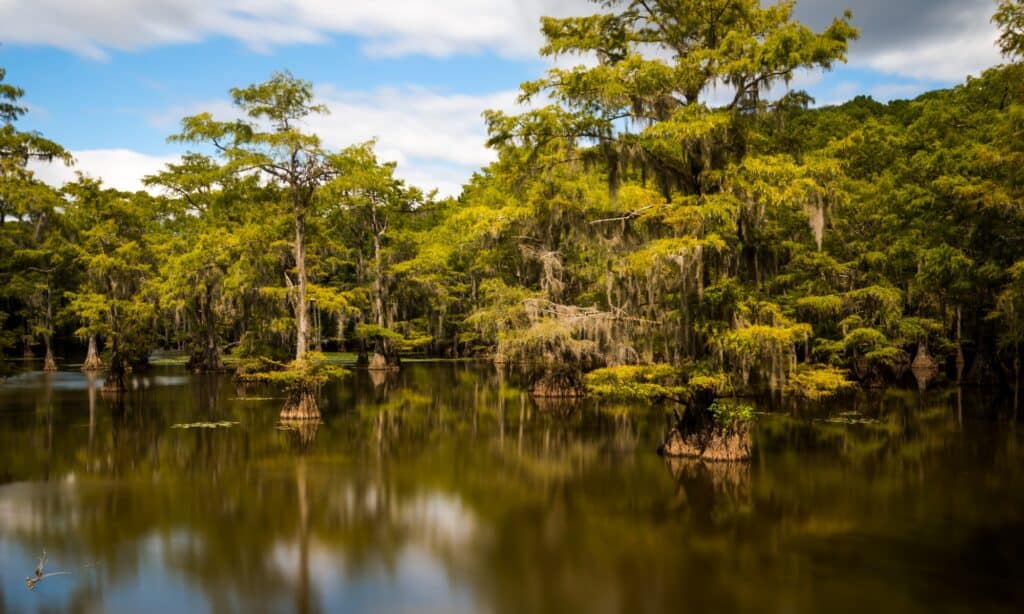
Caddo Lake is known to have crayfish snakes, western worm snakes, timber rattlesnakes, and pygmy rattlesnakes.
©Victoria Ditkovsky/Shutterstock.com
Located on the border between Texas and Louisiana in the northeast portion of the state, Caddo Lake has sizeable parts in the southern Texas county of Marion as well. The 25,400-acre lake, which runs as deep as 20 feet, has an abundance of fish, birds, and quite a number of snake sightings.
According to a 1995 study, some of the most populous reptiles in the area are snakes, which make up 60% of all spotted reptiles. The study also found that at least 32 snake species are located in and around the lake. These species include the crayfish snake and the western worm snake – the first two species to be officially identified in the lake. Other common species include eastern coral snakes, cottonmouths, timber rattlesnakes, and pygmy rattlesnakes.
Some of the Venomous Snakes Found In Texas Lakes
- Southern Copperhead
- Eastern Cottonmouth
- Western Cottonmouth
- Western Diamondback
- Timber Rattlesnakes
- Pygmy Rattlesnakes
- Canebrake Rattlesnake
- Eastern Coral Snake
How To Stay Safe When Visiting a Snake-Infested Lake in Texas
When visiting lakes in Texas, it is extremely important to note that snakes can be anywhere and that many are dangerous. It is important to keep some safety tips in mind in order to avoid getting bitten. Here are just a few:
1. Check With the Authorities Before You Swim
Due to infestations by snakes and other reptiles, some parts of a lake may be closed off to swimming. This is done to keep visitors away from snakes and prevent bites, so following such instructions is imperative. You should also check with park rangers or any other local authorities about where you can and cannot swim.
2. If You Spot a Snake, Don’t Get Close
If you live in Texas, chances are you’ll spot a snake. When you do, do not panic or make any startling motions – you do not want to scare the snake. Instead, back away slowly and do not attempt to get close to it. Once you are safely away, alert the park or lake security so they can get trained experts to safely remove it.
3. Stick to Clear Paths After Sundown
Many water snakes, such as the cottonmouth, are nocturnal creatures, so you’re more likely to run into them when the sun is down. Hence, if you’re visiting a lake with snakes, avoid bushy and grassy areas after sundown. Stick to clean and clear-cut paths and you’ll be less likely to surprise a snake.
Summary of the Most Snake-Infested Lakes in Texas
| Rank | Lake |
|---|---|
| 1 | Inks Lake |
| 2 | Toledo Bend Reservoir |
| 3 | Sam Rayburn Reservoir |
| 4 | Lake Texoma |
| 5 | Amistad International Reservoir |
| 6 | Lewisville Lake |
| 7 | Caddo Lake |
The photo featured at the top of this post is © Daniel Mullins/Shutterstock.com
Sources
- Caddo Lake Institute, Available here: https://caddolakeinstitute.org/homepage/species-of-caddo/
- Texas Parks & Wildlife, Available here: https://tpwd.texas.gov/state-parks/inks-lake/nature
- , Available here: https://www.lasr.net/travel/state.php?Sam+Rayburn+Wildlife+Viewing&TravelTo=TX05lk002&VA=Y&Attraction_ID=TX05lk002a006
- kxii.com, Available here: https://www.kxii.com/content/news/Snake-sightings-increase-in-Texoma-483526261.html
Thank you for reading! Have some feedback for us? Contact the AZ Animals editorial team.






